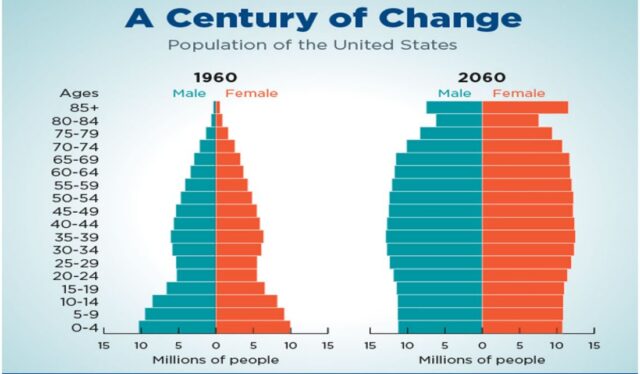Aging populations and staff burnout combine to create a perfect storm for the U.S. healthcare staffing shortage

For the first time in US history, older adults will outnumber younger individuals by 2034.
The global population is top-heavy with more than 1 in every 6 Americans falling in the 65 or older age range (AARP, 2023). As the population ages and we see a continued increase in patients with more than one chronic condition, the demand on healthcare providers will not lessen in the upcoming decades (CDC, 2022).
The COVID-19 pandemic pushed providers, nurses, technicians, and administrative staff to their limits. A 2022 survey showed that 47% percent of healthcare providers plan on leaving their roles in the next two to three years (Forbes, 2022). As a higher volume of patients require complex and frequent care and staff continue to leave the industry, organizations need to look outside the box to solve staffing issues.
Salesforce’s Health Cloud, Data Cloud, and Einstein GPT combine to revitalize workforce efficiencies
Salesforce is a powerful software-as-a-service platform. The platform offers an array of impressive capabilities to organizations, including organizations that fall into the healthcare space. When generative technology is married with the power of Salesforce’s data management capabilities of Data Cloud and Health Cloud to make a solution set, healthcare organizations are enabled to tackle staffing issues head-on.
Enabling Workforce Optimization
Einstein GPT (Generative Pre-trained Transformer) is a natural language generation tool. It leverages AI to transform data into actionable insights. Paired with Salesforce’s Data Cloud and Health Cloud capabilities and electronic medical record (EMR) integrations, here is a sneak peek at how these sets of tools can tackle healthcare staffing shortages:
- Data-Driven Staffing: Einstein GPT incorporates historical patient traffic trends and staffing patterns to create predications around peak patient traffic periods and staff availability. Healthcare organizations are provided automated insights to proactively adjust staffing levels to meet projected demands. This minimizes staff overload and care delays while keeping patient and staff satisfaction top-of-mind.
- Matching Staff Skills to Care Needs: Health Cloud offers provider skill credentialing and management. Einstein GPT analyzes staff credentials and focus areas against patient care needs to highlight care gaps and overburden. If ongoing gaps persist, organizations can use GPT capabilities to generate training plans to ensure care demands are met with appropriately trained staff.
- Intelligent Shift Scheduling: Einstein and Health Cloud securely integrate necessary EMR and appointment information to assist schedulers in finding the best-fit appointment times and locations. For example, if a new physician office opened up and a patient needs to be seen same-day, the scheduler can quickly see which clinics are over-staffed. The system provides suggested locations based on the patient’s address, staff availability, care level, and desired times.
- Patient-Centered Staffing: Einstein GPT analyzes patient show and no-show data. The system can then predict the most likely times that a patient will show up to their appointment. This reduces no-shows and allows for best-fit appointment scheduling and highest return for staff schedule utilization.
Data-Driven Efficiencies: Salesforce Data Cloud and Einstein GPT
Let’s imagine a scenario where a prompt care clinic faces recurring staff shortages on weekends. Staff are getting burnt out, agency workers are burning the budget, and the talent acquisition team cannot keep up. Here’s Data Cloud and Einstein GPT addresses the challenge:
- Data Gathering: Data Cloud brings together necessary appointment, provider, and care outcomes data. With this, it creates unified view for each patient and staff member. Integrating with the scheduling and time off system, it compiles upcoming staff availability and historical appointment information.
- Insight Generation: Einstein GPT harnesses this data, highlighting patterns of patient traffic, types of care needed, and staffing expectations from front desk staff to nurses and physicians.
- Proactive Staffing: With these actionable insights, staffing coordinators can look weeks ahead to ensure the proper level of staffing. They can leverage data-driven insights to ensure staff is available for their projected traffic patterns. The team can also ensure their staff can take their deserved time off and budgets remain balanced.
Maintenance and Expectation Considerations
While AI is not necessarily a new technology, the advent and allowance of public access to large language models and public data sets (e.g., Chat GPT and Open.ai) has opened up an array of groundbreaking opportunities. There is a lot of hype around AI and machine learning (Gartner, 2022) and ss innovation continues to evolve in the AI space, it will be vital that organizations remember the irreplaceable value of humans. Human beings bring intuition, empathy, experience, and training where AI often falls short. The goal of AI tools such as Einstein GPT is to enhance capabilities and streamline workflow processes, not replace humans. Ethical considerations like patient privacy and data security remain paramount, ensuring that sensitive information is handled with the utmost care.
AI-based tools are not meant to be spun up and left. They require ongoing evaluation, audit, and training to ensure accurate results and outcomes. Luckily, in today’s world of information overload, AI and Salesforce have solutions for that. Responsible innovation is possible, especially if the proper planning and execution are incorporated in the roadmap.
In Conclusion
As the population continues to age and chronic conditions rise, staffing needs will remain top-of-mind for the healthcare industry. The merging of Health Cloud, Data Cloud, and Einstein capabilities creates a powerful platform for organizations to proactively tackle staffing issues. Organizations should act now to strategically incorporate technology that can streamline the balancing act of patient care and staffing.
Ready to Enable Your Workforce for The Current and Future Demand?
Contact us today for a demo: samantha.ziegel@perficient.com
References:
AARP. https://www.aarp.org/livable-communities/livable-in-action/info-2019/us-census-and-aging.html
Center for Disease Control and Prevention (CDC). Promoting Health for Older Adults. 2022. https://www.cdc.gov/chronicdisease/resources/publications/factsheets/promoting-health-for-older-adults.htm
Gartner. What’s New in Artificial Intelligence from the 2022 Gartner Hype Cycle. Sept 2022. https://www.gartner.com/en/articles/what-s-new-in-artificial-intelligence-from-the-2022-gartner-hype-cycle
Forbes. New Survey Shows That Up To 47% Of U.S. Healthcare Workers Plan To Leave Their Positions By 2025. 2022. https://www.forbes.com/sites/jackkelly/2022/04/19/new-survey-shows-that-up-to-47-of-us-healthcare-workers-plan-to-leave-their-positions-by-2025/?sh=73614325395b
National Center for Health Statistics (NCHS). Births: Final Data for 2021. 2023. https://www.cdc.gov/nchs/data/nvsr/nvsr72/nvsr72-01.pdf

The blog discusses the pressing staffing challenges faced by the healthcare industry, exacerbated by factors such as an aging population, increasing chronic conditions, and a significant percentage of healthcare providers planning to leave their roles in the coming years. To address these challenges, Salesforce’s suite of solutions, including Health Cloud, Data Cloud, and Einstein GPT, are proposed as innovative tools to enhance workforce efficiencies. By leveraging AI-driven insights, these tools enable healthcare organizations to proactively manage staffing levels, match staff skills to care needs, optimize shift scheduling, and improve patient-centered staffing practices. While emphasizing the importance of responsible innovation and the continued value of human expertise in healthcare, the blog underscores the urgent need for organizations to integrate technology solutions to effectively navigate staffing issues in the evolving healthcare landscape.